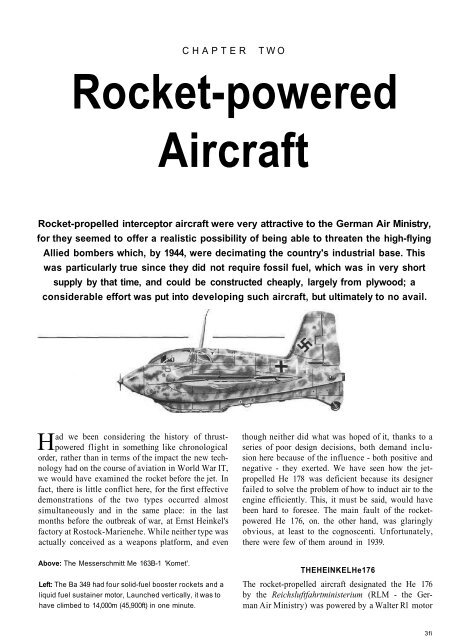Submarines and their Weapons - Aircraft of World War II
Submarines and their Weapons - Aircraft of World War II
Submarines and their Weapons - Aircraft of World War II
You also want an ePaper? Increase the reach of your titles
YUMPU automatically turns print PDFs into web optimized ePapers that Google loves.
CHAPTER TWO<br />
Rocket-powered<br />
<strong>Aircraft</strong><br />
Rocket-propelled interceptor aircraft were very attractive to the German Air Ministry,<br />
for they seemed to <strong>of</strong>fer a realistic possibility <strong>of</strong> being able to threaten the high-flying<br />
Allied bombers which, by 1944, were decimating the country's industrial base. This<br />
was particularly true since they did not require fossil fuel, which was in very short<br />
supply by that time, <strong>and</strong> could be constructed cheaply, largely from plywood; a<br />
considerable effort was put into developing such aircraft, but ultimately to no avail.<br />
Had we been considering the history <strong>of</strong> thrustpowered<br />
flight in something like chronological<br />
order, rather than in terms <strong>of</strong> the impact the new technology<br />
had on the course <strong>of</strong> aviation in <strong>World</strong> <strong>War</strong> IT,<br />
we would have examined the rocket before the jet. In<br />
fact, there is little conflict here, for the first effective<br />
demonstrations <strong>of</strong> the two types occurred almost<br />
simultaneously <strong>and</strong> in the same place: in the last<br />
months before the outbreak <strong>of</strong> war, at Ernst Heinkel's<br />
factory at Rostock-Marienehe. While neither type was<br />
actually conceived as a weapons platform, <strong>and</strong> even<br />
Above: The Messerschmitt Me 163B-1 'Komet'.<br />
Left: The Ba 349 had four solid-fuel booster rockets <strong>and</strong> a<br />
liquid fuel sustainer motor, Launched vertically, it was to<br />
have climbed to 14,000m (45,900ft) in one minute.<br />
though neither did what was hoped <strong>of</strong> it, thanks to a<br />
series <strong>of</strong> poor design decisions, both dem<strong>and</strong> inclusion<br />
here because <strong>of</strong> the influence - both positive <strong>and</strong><br />
negative - they exerted. We have seen how the jetpropelled<br />
He 178 was deficient because its designer<br />
failed to solve the problem <strong>of</strong> how to induct air to the<br />
engine efficiently. This, it must be said, would have<br />
been hard to foresee. The main fault <strong>of</strong> the rocketpowered<br />
He 176, on. the other h<strong>and</strong>, was glaringly<br />
obvious, at least to the cognoscenti. Unfortunately,<br />
there were few <strong>of</strong> them around in 1939.<br />
THEHEINKELHe176<br />
The rocket-propelled aircraft designated the He 176<br />
by the Reichsluftfahrtministerium (RLM - the German<br />
Air Ministry) was powered by a Walter Rl motor<br />
3fi


